The Story of the Pipe Organ Project at
Bethel Lutheran Church, Round Lake, Minnesota
Paul Soulek, organist
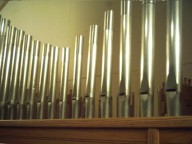
Starting at the beginning:
1985
After serving the Bethel congregation well, it was time to replace an aging Gulbransen tube-type organ. The Rodgers organ dealer was closing out of business, so a new Rodgers electronic organ (1984 model 650 A) was purchased for $8,000. The new Rodgers organ served the Bethel congregation well, requiring no maintenance or service calls.
2001
The organ console was rotated 90° in late 2001 so the organist would have a better view of the chancel area. Before this rotation, the organist sat with their back to the chancel, depending on an array of mirrors for a view.
In late 2001, Charles Hendrickson, president of Hendrickson Organ Company of St. Peter, MN, gave me the parts to build a one-rank pipe organ chest. The Rodgers organ was designed to control pipes, so we only needed to purchase a small amount of equipment. At the January 2002 Voters' Meeting, the congregation unanimously approved the project, and voted to pay for the circuit board and power supply. A donor stepped in, and paid for the project in memory of her late husband. The entire pipe organ project was completed with only $80 of church funds, which was used to build the organ "case". Installing the pipes required some modification to the balcony floor plan; a row of seats at the rear of the balcony was removed, and a frame structure was built to support the pipes. The windchest, which was 8' long by 11" wide, was placed on the frame structure. My dad and I built the chest. We had fun doing the design work and pipe placement using a spreadsheet. :-)
2002
The push was on in late February when our congregation found out that our pastor would be taking a call to a church in Illinois, and would be leaving after Easter Sunday. That left around a month to build the chest and install the pipes. March was unusually snowy (meaning lots of school cancellations), so we got the project done on time. The chest and pipes were brought to the church and installed on March 20th. When everything was hooked up for the first time, the pipes didn't work at all. After many long hours at the church, Dennis Bucholz discovered that a loose fuse on the pipe driver board was to blame. The metal clips that held the fuse in place were loose, therefore not allowing current to flow through the fuse and leaving an open circuit. After this problem was fixed on Thursday night, the organ worked just like it should have. The organ was dedicated to the Glory of God on Sunday, March 23, 2002.
The Kilgen pipes were replaced (from 2' up) on April 5th, for a brighter sound.
A sound sample of the organ using the pipes is available by clicking here. This clip was taken during the summer of 2002, with the new principal pipes. The sound clip takes about one minute to download on a normal modem. That sound clip is of "Thy Strong Word", a hymn found in our Lutheran Worship hymnal, number 328. The hymn is played through using the full principal chorus of the electronic organ, and the principal pipes operating at 8' & 4'. At the end of the hymn, a short clip is played using the electronics only, so you can hear what a difference the pipes make. The sound clip was recorded in the middle of the sanctuary using a video camera microphone, so the sound quality is not the best. This recording was also taken before some improvements were made to the organ, as described below.
During the summer of 2002, we got a 73-note 8' Gedeckt rank and chest (for notes 16-73) from Charles Hendrickson. A driver board was purchased.
2003
During Christmas 2002 and early January 2003, we worked on getting the Gedeckt rank working. Notes 16-73 were first used on January 19th, 2003. Notes 1-15 did not fit on the chest. We built a new direct electric chest for notes 1-15.
The summer of 2003 brought many interesting difficulties and changes. The original layout of the organ didn't lend itself well to the addition of the Gedeckt rank, so the blower, reservoir, and chests were moved to accommodate a new layout. Many problems were also fixed during this time. I caused some problems with the power supply during this time, so the pipes didn't speak for most of July 2003. As a result of many hours of troubleshooting by congregation member Jason Ling, the organ is working today. It was fixed the day before I left for college. During October 2003, Howard Nolte of Ulm Orgelwerke provided tonal regulation and voicing of the principal rank. The "casework" around the organ was also completed at this time.
I played the entire organ together for the first time on Sunday, October 19, 2003. I am truly thankful for the congregation of Bethel for being so patient, kind, and supportive throughout this whole project. This pipe/electronic combination organ is a wonderful addition to the worship life at Bethel Lutheran Church.
Photos...from the beginning....
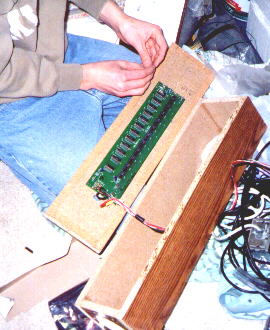
(late February 2002) This is the circuit board that controls the chest
magnets. Every pipe has a magnet under it that controls the supply of air
to the pipe. Each chest magnet (there are 73 total on the chest) has one wire
coming to the circuit board. A "common" wire is also connected to the circuit
board.
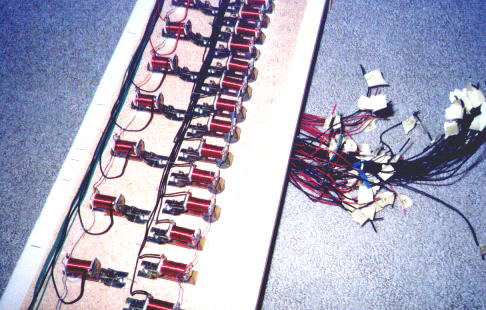
(late February 2002) This is a view of the chest magnets. Each magnet
covers up a hole, and when the magnet is energized by the pipe driver board, the
magnet opens and allows air to travel into the pipe.
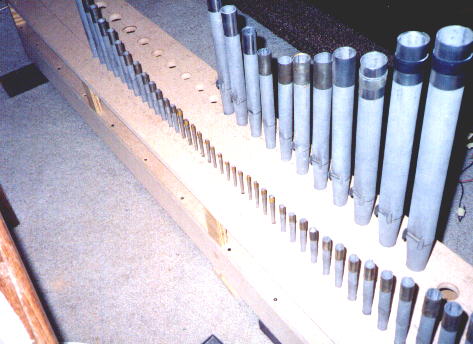
(early March 2002) This is a view of the chest while still in the
"shop" (our basement) during testing.
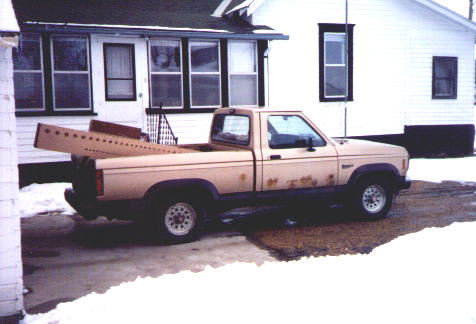
(early March 2002) This picture is kind of an inside joke for Bethel
members; to move the chest we used Pastor Werner's old truck. After it died in
our driveway, it surprisingly started back up and made it down to church.
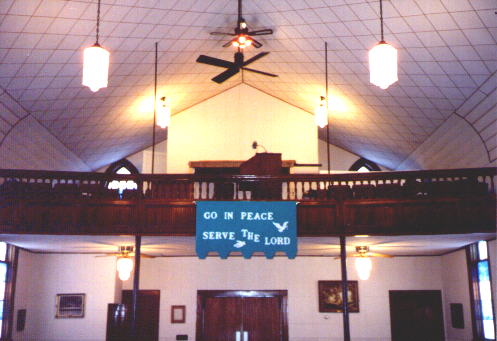
(early March 2002) This is what the balcony looked like before the
pipes were installed---notice the framework for the chest is already in
place.
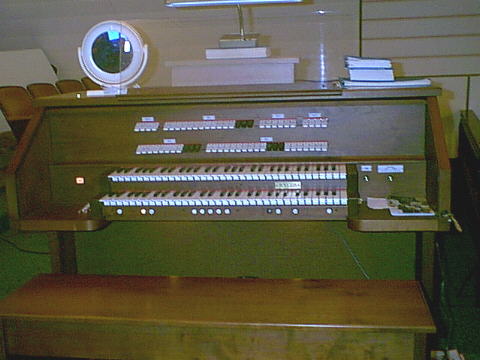
This is the console of our Rodgers
organ, which was installed in 1985.
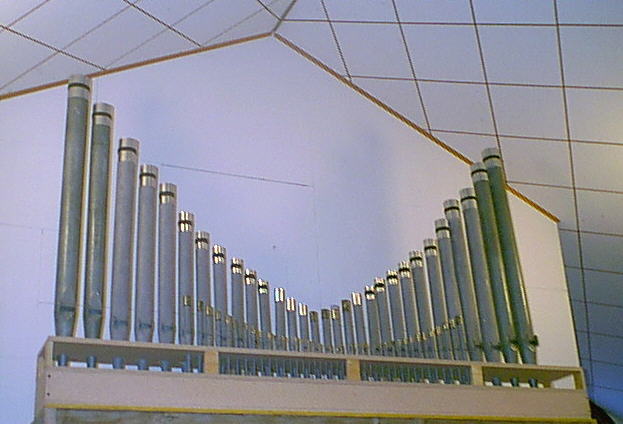
(March 2002) This is a view of the
principal chest with the
first set of lead Kilgen pipes.
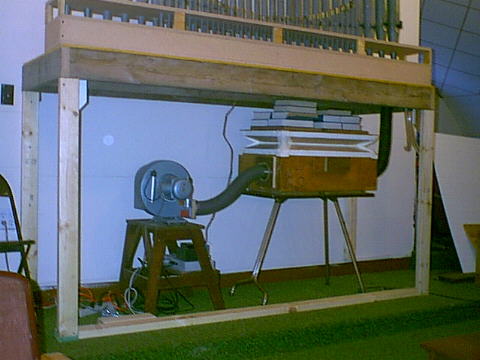
(March 2002) Here is a view of the blower and
reservoir with the frame structure exposed. (The hymnals on the reservoir add
that "professional" touch.)
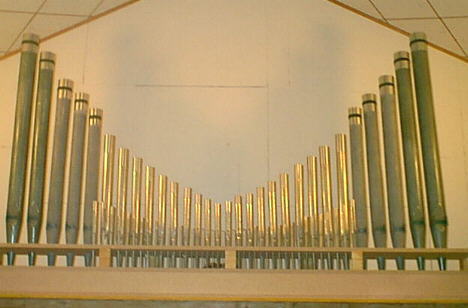
(May 2002) A view of the principal chest.
The longest pipe is 4' long. (You can see the shiny new pipes in the middle,
with the darker grey pipes on the ends being retained from the Kilgen rank.)
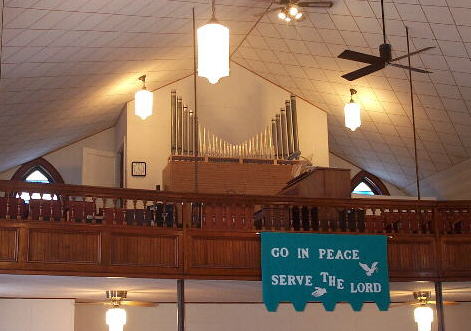
(July 2002) The principal rank as viewed from the front of
the sanctuary.
(November 2003) It's me playing the organ! (note the addition
of a blower cutoff switch (white) on the left side of the console---in case
there is a cipher, the organist can turn off the blower without turning off the
electronic portion of the organ)
(November 2003) The finished product.
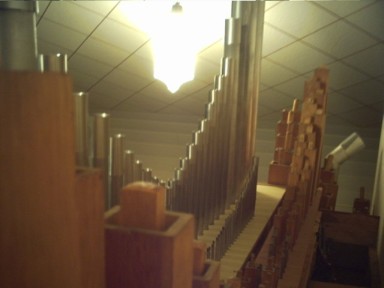
(December 2004) Looking from the back.
(November 2003) The finished product as viewed from
downstairs.
The Stoplist
Great
8' Principal (Positiv - lowest octave electronics )
8' Bourdon (Positiv)
8' Gemshorn
4' Octave (Positiv)
4' Flute (Positiv)
2-2/3' Nasat (Positiv)
2' Super Octave (Positiv)
2' Waldflote (Positiv)
Mixture IV
Main Tremulant (affects all electronics)
16' Swell to Great
8' Swell to Great
4' Swell to GreatSwell
16' Bourdon Doux
8' Gedackt
8' Gamba
4' Principal
4' Nachthorn
2-2/3' Nasard
2' Blockflote
1-3/5' Tierce
1' Sifflote
Plein Jeu IV
8' Trompette
8' Oboe
16' Swell to Swell
Swell Unison Off
4' Swell to SwellPositiv (2 ranks, 158 pipes)
8' Bourdon
4' Principal
4' Flute
2' Octave
1-1/3' Quint
Pipe Tremulant (not installed)Pedal
16' Subbass
16' Bourdon Doux
8' Octave
8' Flute (Positiv)
4' Choralbass (Positiv)
4' Nachthorn (Positiv)
2' Flute (Positiv)
Mixture IV
8' Great to Pedal
8' Swell to Pedal
4' Swell to PedalGenerals (affects entire organ)
Celeste
Flute Tremulant Flute
Main Chorus
Reeds FF
Main Off
Antiphonal On
Great/Pedal Pipes Off
Great/Pedal Ancillary On (turns on electronic doubling for Great and Pedal pipe stops)Accessories
Two memory levels with five general pistons each
Solo and Continuo pistons
Expression pedal (affects electronic stops only)